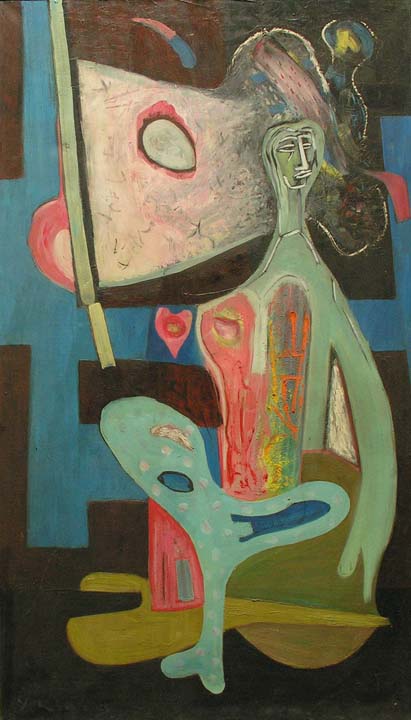

YEHOSHUA KOVARSKY
OIL ON CANVAS, SIGNED
LITHUANIAN/AMERICAN, C.1950'S
53 X 30 INCHES
Yehoshua Kovarsky Kovarsky was born in the city of Vilna, Lithuania to a traditional Jewish family. His father and uncle owned a concession for painting railroad stations, trains and bridges, and were responsible for commissioning artists to execute murals. Between the years 1920-1925, Kovarsky attended a Yiddish Gymnasia in Vilna and later a governmental school of art. At the age of 17, he was sent to Palestine, where he worked on a “Kibbutz” (collective settlement) for a period of time, during this time he drained swamps, paved roads and worked in citrus groves. He attended the Bezalel Academy of Art and Design in Jerusalem for a short time, and worked for the young Hebrew Theater in Tel- Aviv as a set designer and wanted to become an actor. In 1928, Kovarsky returned to Vilna and studied in the Academy of Fine Arts where he had his first exhibition. He went to Paris in 1931, with his parents’ expectations that he would study law. Instead, he joined the art studios of Paul Colin (1892-1985) and Andre Lhote (1885-1962). In 1936 he came back to Israel. He stayed in Tel- Aviv and worked as a decorator for the Levant Fair. In 1938, he returned to France and worked in his brother’s home in Metz. When World War II broke out, Kovarsky fled to Palestine leaving behind most of his works, which were ruined in the raids. In his first few years in Israel he isolated himself in order to focus on painting. Most of his paintings from this period are of the ancient city of Safad- cradle of Jewish mysticism and Cabalism, Which was also known as a colony of artists. In 1944 he moved to Zichron Ya’acov and taught art in Shfeye. 1n 1949, he settled in Jerusalem and a year later he married Corinne Chochem, a Martha Graham dancer. In 1951, although already established as a known artist in Israel, Kovarsky and his wife decided to move to the USA. First they traveled in California and North Carolina, and then settled in New York City. In 1954, he exhibited in the annual exhibition of the Pennsylvania Academy of Fine Art. In 1957, Kovarsky returned again to Israel for two years and then came back to New York. From1959 on, he lived in Los Angeles. In 1967, a short time after the Six Days War, Yehoshua Kovarsky died. Kovarsky and his wife always planned on returning to Israel to retire, but unfortunately they never got the chance to do so. The artist’s stay in Paris and New York is reflected in his work. He absorbed all the Surrealists’ ideas, the interest in Mythology, Archetypes and the depth of the self that were popular in 1920’s Paris, and that have matured into the Abstract Expressionism in the mid 1940’s in New York. For Kovarsky, above all, painting was a mean of discovering the true self, as he himself had expressed: “The image is hiding somewhere inside, you try to fix it and you get closer to what is hiding inside of you…you have more then you are able to express and that is way you are trying to go back inside…it is the same as trying to reach god- higher you go, he is still remains higher then you”. (1966) Kovarksy exhibited at many places including: Katz gallery, Tel Aviv; Pasadena Art Museum; San Francisco Museum of Art; Passedoit Gallery, New York; Tel Aviv Museum; Cincinnati Art Museum; Schneider Gallery, Rome; Gallery One, London; Santa Barbara Museum of Art; Jewish Museum, New York; University of Haifa, Haifa, among others. His work is in the collections of the following institutions: San Francisco Museum of Art, Pasadena Art Museum, Mint Museum of Art, Charlotte, NC, Jewish Museum, New York, New Sinai Temple, Los Angeles, Tel Aviv Museum, Bezalel Museum, Jersalem, Ein Harod Museum, Ain-Harod, and the University of Haifa, Haifa. Many other works are in private collections in the United States and Israel. |